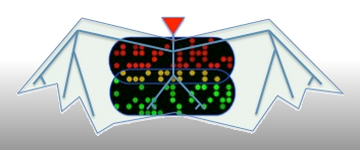


VAMPhyRE Applications Server
The Virtual Analysis Method for Phylogenomic fingeRprint Estimation (VAMPhyRE) is a bioinformatics technique aimed for whole-genome comparisons and phylogenomic analysis using Virtual Genomic Fingerprints (VGFs). VGFs are calculated by Virtual Hybridization (VH), which is a computational method that searches potential hybridization sites for short probes on genomic sequences.
This search locates potential hybridization sites between genome sequences and the probes in a defined set (The VAMPhyRE probe set), based on the number of complementary bases allowing a defined number of mismatches. Additionally, the program can perform a thermodynamic analysis for predicting the thermal stability of the duplexes formed between probes and potential hybridization sites, which can be used for the development of microarray devices.
The VAMPhyRE probe sets (VPS) were designed using special criteria
to maximize the variability of the genomic sequences that can be analyzed and for producing
specific hybridization patterns even for closely related genome sequences.
The collection of potential hybridization sites in the targets constitutes a hybridization
pattern called Virtual Genomic Fingerprint (VGF).
In order to produce highly specific and informative VGFs, the probe set is selected according
to the length of the target genome to produce a fingerprint where is expected the hybridization
of approximately 50-60% of the probes in the set, while covering most of the target genome.
Genome similarity is then estimated by pairwise comparison of their VGFs, using special techniques for counting the number of shared homologous hybridization sites. VGFs similarity is reported as distance tables that can be used for calculating phylogenomic trees.
Click here for downloading the VAMPhyRE software
Please citate:
- Muñoz-Ramírez ZY, Mendez-Tenorio A, Kato I, et al. Whole Genome Sequence and Phylogenetic Analysis Show Helicobacter pylori Strains from Latin America Have Followed a Unique Evolution Pathway. Front Cell Infect Microbiol. 2017;7:50. Published 2017 Feb 28. doi:10.3389/fcimb.2017.00050
- Méndez-Tenorio A, Flores-Cortés P, Guerra-Trejo A, et al. In silico evaluation of a novel DNA chip based fingerprinting technology for viral identification. Rev Latinoam Microbiol. 2006;48(2):56-65.
- Reyes-López MA, Méndez-Tenorio A, Maldonado-Rodríguez R, Doktycz MJ, Fleming JT, Beattie KL. Fingerprinting of prokaryotic 16S rRNA genes using oligodeoxyribonucleotide microarrays and virtual hybridization. Nucleic Acids Res. 2003;31(2):779-789. doi:10.1093/nar/gkg132
